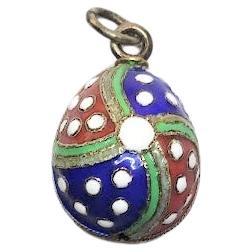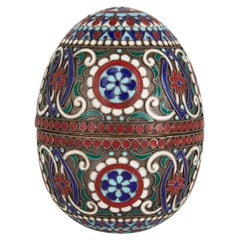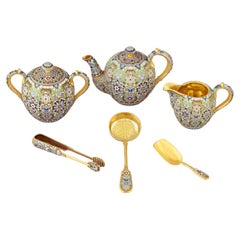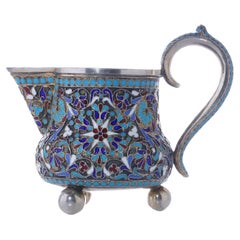Questions & Answers
Our trusted network of 1stDibs sellers answer common questions
What is cloisonné jewelry?
1 Answer

Cloisonné jewelry is jewelry that has been decorated with a distinctive enameling technique.
Cloisonné (“cell” in French) is a technique in which thin wires of fine silver or gold are used to outline a design, which is then filled with enamel. The piece is subsequently placed in a kiln where the enamel is melted. Cloisonné is distinct because the individual wires remain visible, forming an outline of the motif.
Over the years, enameling has become an art form. This is partly because of its durability: Although the colors may change during firing, once cooled, they’re set and never fade. They can also be made either opaque or translucent — just one example of the flexibility that is another reason artists are attracted to the medium.
When it comes to jewelry design and other disciplines, cloisonné enamel was popular during the Byzantine Empire (artisans living in France and Germany in the Middle Ages preferred champlevé). By the 7th century, Lombard craftsmen in northern Italy were using enamel to emulate Byzantine objects. In the 12th and 13th centuries, artisans in China imported the technique and made it so much their own that enameled objects have long been associated with Eastern aesthetics and motifs rather than Western ones.
Find cloisonné jewelry on 1stDibs.
Cloisonné (“cell” in French) is a technique in which thin wires of fine silver or gold are used to outline a design, which is then filled with enamel. The piece is subsequently placed in a kiln where the enamel is melted. Cloisonné is distinct because the individual wires remain visible, forming an outline of the motif.
Over the years, enameling has become an art form. This is partly because of its durability: Although the colors may change during firing, once cooled, they’re set and never fade. They can also be made either opaque or translucent — just one example of the flexibility that is another reason artists are attracted to the medium.
When it comes to jewelry design and other disciplines, cloisonné enamel was popular during the Byzantine Empire (artisans living in France and Germany in the Middle Ages preferred champlevé). By the 7th century, Lombard craftsmen in northern Italy were using enamel to emulate Byzantine objects. In the 12th and 13th centuries, artisans in China imported the technique and made it so much their own that enameled objects have long been associated with Eastern aesthetics and motifs rather than Western ones.
Find cloisonné jewelry on 1stDibs.
1stDibs ExpertApril 8, 2024
Shop for Russia Cloisonne on 1stDibs
Russian Cloisonné Enamel and Silver Gilt Egg
Located in London, GB
Russian cloisonné enamel and silver gilt egg
Russian, 20th Century
Height 7cm, diameter 5cm
The
Category
20th Century Russian Models and Miniatures
Materials
Silver, Enamel
Russian Cloisonné Enamel Tea Set
By Pavel Ovchinnikov
Located in New Orleans, LA
This exceptional Russian cloisonné and enamel tea set is the work of Pavel Akimovich Ovchinnikov
Category
Antique 19th Century Russian Japonisme Tea Sets
Materials
Silver, Enamel
Antique Russian Cloisonné Enamel and Silver Gilt Milk Jug
Located in Braintree, GB
Antique Russian Cloisonné Enamel and Silver Gilt Milk Jug.
Details:
Maker: Unidentified (hallmarks
Category
Antique 1890s Russian Sterling Silver
Materials
Silver, Enamel
Russian Cloisonné Enamel and Silver-Gilt Kovsh
Located in London, GB
. Kovshes have been created in Russia for centuries, often from precious materials, such as silver, gold
Category
Early 20th Century Russian Sterling Silver
Materials
Silver, Enamel
Imperial Russian Cloisonne Enamel Necklace, Workmaster Alexander Dalman
Located in Chesterland, OH
-1905 — a necklace with a pendant made of unique cloisonné enamel, made in the old Russian style. The
Category
Antique Late 19th Century Russian Russian Empire Chain Necklaces
Materials
Silver, Enamel, Gilt Metal
Imperial Russian Cloisonne Enamel Egg Pendant, Workmaster Ivan Khlebnikov
By Ivan Khlebnikov
Located in Chesterland, OH
This workmaster Ivan Khlebnikov gilt cloisonne enamel egg pendant is a unique piece that echoes the
Category
Antique Late 19th Century Russian Russian Empire Pendant Necklaces
Materials
Rhodolite, Silver, Enamel, Gilt Metal


